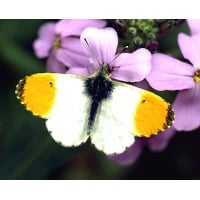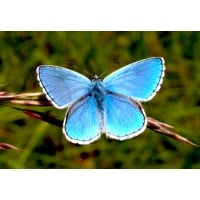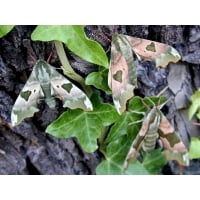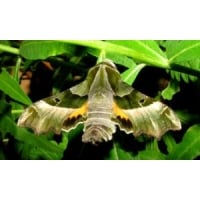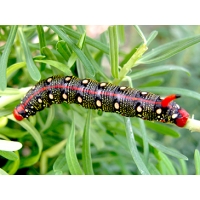CURRENT PUPAE - Chrysalides and cocoons
If you are a beginner and need information on rearing from small caterpillars, or hatching out pupae, please order the All Colour Paperback BUTTERFLIES. INSTRUCTIONS ARE NOT SENT WITH EACH SPECIES, you need to acquire basic skills and this book is a simple way of doing so.
Please Select a Category Below:
Orange Tip Anthocharis cardamines Europe
Store the pupae in a cool place, for the winter, even a refrigerator, loose in a plastic box. An early spring butterfly. Depending on locality and season, the butterflies usually begin to fly in May. The male has the orange tips. Both sexes have mottled undersides in green which is actually made of microscopic scales of black and yellow, giving the illusion of green. The curious pupae look like thorns.
Eggs are laid on Garlic Mustard, Sweet Rocket and Cuckoo Flower or Lady’s Smock. The larvae live singly and are canabalistic. Not difficult to breed, particularly on potted foodplant. Camouflage in all stages is remarkable.
WORLD SWALLOWTAIL PUPA COLLECTION 10 pupae
These are unidentified, very varied in shape, size, colour and pattern. They are mostly tropical or sub-tropical and for emergence provide warmth and humidity that the pupae normally have in their natural environment.
These are some of the loveliest butterflies of all butterflies. They come, unlabelled, ready to emerge and surprise you. Some may form up and emerge within a few days, others may take a month or more. When possible ten different species will be supplied.
Photos on this site are representative and, as there are so many species, your collection may have any of the possible species, not necessarily those illustrated.
Map Butterfly Araschnia levana
A charming and quite small Vanessid butterfly that occurs throughout much of Europe but not in the British Isles. It has been established in Britain but the colony was deliberately destroyed. This is a nettle feeder.
The eggs are laid in unique pendant strings from the underside of a nettle leaf. Younger larvae are gregarious.
There are normally two broods: the spring brood is patterned rather like a fritillary, as illustrated. In July the second brood (form porosa) emerges looking like miniature White Admirals!
An established British colony was deliberately exterminated. Why not try again?
Pairing is not easy but success is more likely if you can create a netting sleeve that brings the two sexes together, like the peak of a hood. Second brood larvae hang up to pupate in secluded places for the winter. The pupae we are offering now are to be stored in a cool outhouse or fridge until April. Then lay them out for emergence in April/May.
World Collection of Exotic Butterflies
From several world regions and families. Un-identified, selected for beauty and interest. The pupae alone are things of great beauty and interest. One of the real joys of nature!
Choose between the STANDARD World Collection and the DE LUXE World Collection. Both are varied and interesting. The DE LUXE includes such beauties as the shimmering blue Morpho, Giant Owl Butterflies, Larger exotic Swallowtails, Iridescent blue banded Prepona and the like. The pupae are usually larger and some very intricate. Well worth the difference in price. Some species develop in the pupa quite fast, which is why for international orders it is essential to send by courier, though this does not guarantee safe arrival, particularly in summer and to hot countries. in cooler months pupae usually arrive safely.
Illustrations are representative: yours may not be these species as there are so many to choose from - good value is always assured. When possible 10 different species will be sent though this is not always possible.
IMPORTANT - Please read this guide to hatching of exotic butterfly pupae:
Provide warmth and humidity that the pupae normally experience in the tropics. About 30°C is ideal, and humidity above 70%. The butterflies like a warm greenhouse containing varied plants, especially those producing nectar flowers to feed from, and this is the best place also for the emerging cage for the pupae. Examples of nectar flowers include Ixora, Buddleia, Pentas, Eupatorum, Clerodendrum and most Asteraceae (formerly Compositae). Shade the cage from direct sun, which is too harsh. If you don’t have such an environment, you may be able to simulate a warm and humid atmosphere in another way, but don’t apply direct heat. The whole cage needs to be in an even temperature and humidity, which is best provided in a tropical greenhouse environment. It is usually beneficial to mist the pupae at least once a day. It is normal in nature for night to be cooler than day.
It’s a good idea to suspend the pupae. To do this, use a cane held horizontally. Apply a very thin line of contact adhesive eg Evostick along the cane. Lay the cane on a table and, when it is tacky but not yet set hard, touch the tails of the pupae on the line of glue. Warning: excess glue actually kills the pupa, so use just a very thin line. When the glue has set you can pick up the cane, with all the pupae hanging by their tails from it.

Pupae of the Swallowtail and Pierid families don’t hang from the tail (cremaster), head downwards. They are attached to a twig at the tail, and they use a silk sling around the wing cases to anchor themselves, head upwards and at an angle away from the twig. To simulate this, you can take some lengths of cane. Make a thin line of glue as described above. Lay the cane on a table, then attach the tails of the pupae to the glue line, and touch the abdomen also against the glue line. Once dry, the cane can be arranged standing at an angle against the sides of the emerging cage, or you can arrange them stuck into a block of florist’s foam. There needs to be enough space to allow the emerging butterflies to climb up, expand and dry their wings.

Usually fixing the pupae to a cane helps to give hatching butterflies the best foothold. When fixed to canes pupae are very exposed and can easily dry out. Mist them several times a day. If you don’t wish to glue the pupae to a cane, they can be laid out on corrugated card or other rough surfaces, such as greengrocer’s imitation grass mats or coconut matting, flat on the bottom of the emerging cage. This material may help to keep the pupae moist if you spray them at least once a day. For hygiene the material needs to be cleaned or replaced every few days.
Resulting butterflies do well in a tropical greenhouse, planted with lush greenery and copious nectar-bearing flowers. Some species like to feed from over-ripe fruit. They may live 2-4 weeks in such conditions, exceptionally they can live longer. Kept in a cage in a house, their life may be just a few days, but sometimes longer if they are given fresh nectar flowers each day, and misted to prevent the atmosphere becoming too dry. Non-native butterflies must not be released.
Yellow-legged Tortoiseshell Nymphalis xanthomelas
A very handsome and richly coloured Large Tortoiseshell which occurs in parts of Europe and in the Far East. It is also reported to have been found breeding in Britain.
The butterfly, caterpillar and pupae are all brighter and grander than polycholoros. HIGHLY RECOMMENDED!
The larvae feed on Willows, Sallows, Elm, and probably many other trees, including those for polychloros.
A few pupae are available immediately. .
Camberwell Beauty Nymphyalis antiopa
We cannot be sure of obtaining this species every year, and we are lucky to have them again!
Camberwell Beauty larvae feed on Sallow Salix caprea, Willows, Birch and some other trees. The larvae are gregarious nearly until pupation when they are most handsome with long branched spines and wonderful contrasting red blotches on the black ground colour.
In nature the pupae are suspended. In captivity it's wise to do the same. Please see advice on how to suspend pupae in the introduction to Exotic pupae. Keep the pupae moist, by misting with tepid water at least daily. Temperature of 20 deg C or a little more is ideal. Pupae usually hatch in a matter of days if conditions are right.
The Adonis Blue Lysandra bellargus
The intense blue iridescence of the male is unmatched in Europe. The female has a rich burnt umber colouring. To raise the larvae you need Horseshoe vetch Hippocrepis comosa, a low-growing plant, covered with yellow flowers in May, requiring calcareous soil. The larvae, which will also feed on Coronilla, feed rapidly and pupate among the base of the foodplant. In Britain the Adonis is double brooded, the adults flying in June and August.
Lime Hawkmoth Mimas tiliae
Some excellent forms of pattern and colour are appearing from these pupae, including one-spot, banded and brick red forms, as well as a wide colour range of normal pattern. There is no way of detecting these in the early stages, but we are illustrating some of these extreme forms that have been emerging.
Store pupae refrigerated for the winter. The moths normally emerge in May/June.
Extremely easy to rear on Lime or Elm. Other reported foodplants include Cherry, Alder, Birch, Oak, Hazel, Acer including Sycamore, Sorbus, Apple, Pear and Ash! In autumn the larvae will grow faster if kept warm.
The larvae do particularly well sleeved on growing foodplant but can be kept in plastic boxes or cages. Beautiful streamlined larvae. Larger larvae are often heavily marked with flame and scarlet spots and blotches. Very variable. They pupate underground. In captivity they will pupate amongst folds of cloth or absorbent tissue.
Privet Hawk Sphinx ligustri
SPECIAL OFFER 5 pupae £22.95 NOW £17.95 10 pupae £39.95 NOW £35.95 20 pupae £79.90 NOW £66.00
One of the largest Hawkmoths. Keep pupae cool for breeding next year.
The caterpillar becomes enormous and is characteristic of the name Sphinx moths, by its sphinx-like resting position. Adults emerge in June and July. They need nectar from the flowers of Privet, Valerian, Buddleia.
Larval foodplants: Privet, Lilac, Ash, also reportedly Spiraea, Viburnum opulus, and other Viburnums, Holly, Dogwood, Snowberry, Apple, Pear, Oleander, Leycesteria, Currant.
One generation in the year. Privet Hawks breed readily in a large cage with nectar and foodplant.
Willowherb Hawkmoth Proserpinus proserpina
SCARCE! Only a few pupae available.
This rather rare Hawkmoth is a gem, seldom encountered, though it lives throughout much of western and central Europe, eastwards into Russia.
The larva is rather like a grey form of Small Elephant Hawk. The foodplant is Rosebay Willowherb Epilobium, Evening Primrose Oenothera and Purple Loosetrife Lythrum. The pretty little green moth has prominent egg-yolk coloured hindwings. The normal flight period is June and July.
Elephant Hawk Dielephila elpenor
Store winter pupae refrigerated in a plastic box. In the emerging cage it is important to have the pupae moist but well drained. Please see the Pupae Nest on this website. The moths usually emerge in June and July.
Cage the moths with nectar flowers and springs of Willowherb – you do not see the pairings but fertile eggs are easily obtained.
An exceptionally pretty moth with amazing and characterful larvae, with eye-spots and probing “trunks”. Young larvae are green, later changing to charcoal black, with occasional rarities remaining green.
Larvae feed on Willowherbs, Fuschia, Creepers.
Highly recommended.
Spurge Hawk Hyles euphorbiae
A very rare migrant to Britain. They have been found on sand dunes on the southern shores of England.
Fine, healthy pupae to emerge soon. In the emerging cage keep as described for the Pupae Nest on this website.
The moths breed at night and pairings are seldom seen. Provide potted foodplant on which the clusters of green eggs are laid. The larvae are black at first and they are gregarious. As they grow they separate and take on a multitude of amazingly bright and varied colours. The larvae will feed on most Spurges, including the summer weed Sun or Petty Spurge. The moths lay well on the tender shoots and Cypress Spurge Euphorbia cyparissias is a favourite. Larger larvae will feed the coarser Spurges, such as Caper Spurge and Wulfeni.
Pupae are formed on or beneath the surface of the ground. In warm conditions there may be multiple generations. Winter is spent as dormant pupae.
Only a few. They are for breeding in summer.
Dormant pupae are kept cool for the winter. Adults emerge in June/July.
Provide nectar flowers and potted Spurge plants for egg-laying. The best Spurges are Cypress Spurge (cyparissias), Wood Spurge, Sea Spurge, and the annual Sun or Petty Spurges are all suitable. Eggs are laid in clutches near the tips. The young larvae are black and cluster.
Soon they take on amazing spots and stripes of yellow, red, white and green. Some of the most colourful larvae in the world.

